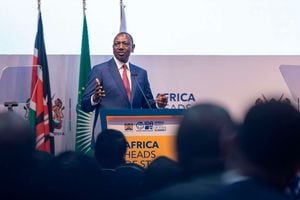Inclusive education is a right for children with disabilities

A teacher displays items by special needs children at Kenya Community Centre for Learning (KCCL) in 2016.
What you need to know:
- The current direction in education is to provide inclusive education for children with disabilities.
- That puts children with disabilities in regular schools, providing an environment that fully engages all students in quality education.
For too long, children with disabilities have not benefited from the educational facilities available in our communities. They have often been secluded in special schools, most of which are inhibitive and are not in tandem with current thinking.
The current direction in education is to provide inclusive education for children with disabilities. That puts children with disabilities in regular schools, providing an environment that fully engages all students in quality education.
In countries where this approach has been adopted, like Canada and United States, it has minimised barriers to education. Many of those who attend school are exposed to systems that do not adequately support their learning needs or provided with lower quality education, including in segregated or special education.
Access to education for children with disabilities is part of the 2030 Agenda for Sustainable Development. Kenya, a signatory of the Sustainable Development Goals (SDGs), need to put in place measures for an inclusive education system. This requires significant structural changes at all educational levels.
First, there is a need for an inclusive education unit to lead county policies and plans to transition towards, and progress, inclusive education. It will enable collaboration between the counties and the national government to streamline and adopt the relevant legislation. The policies would prohibit violence, corporal punishment, harassment and bullying in the education system on the basis of disability.
Inclusive education policies
Secondly, the government would involve children and youth with disabilities, and their representative organisations, in the design, implementation and monitoring of inclusive education policies and programmes. That would help to combat negative stereotypes and attitudes against the inclusion of students with disabilities and highlight its benefits.
Thirdly, the government can ensure that all teachers and teaching support staff undergo compulsory pre-service and in-service training on inclusive education methods and pedagogy as an integral part of teacher-training curricula. That would ensure diversity and gender balance in staff recruitment.
Parents and representative organisations should participate fully in making the education system accountable by lodging complaints concerning the implementation of inclusive education and the authorities allocated budget to support it. Lastly, let us adopt, monitor and enforce accessibility standards.
Persons with disabilities are not yet sufficiently included in the implementation, monitoring and evaluation of the SDGs, especially on education. Inclusive education is not only the right thing to do but also the practical thing to do.
Education is a powerful tool. Investing in the vision of quality education for all is something that communities and governments can do. If we harness our collective power, we can make inclusive education a reality for children with disabilities.
Ms Marangu is a communication and research specialist; [email protected]. Ms Lidubwi is a project lead at Internews; [email protected]





